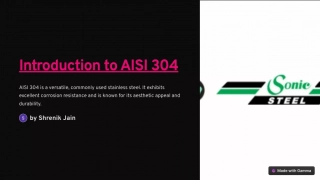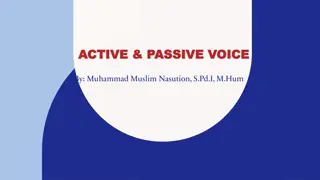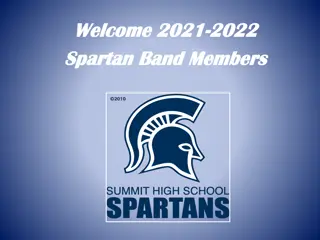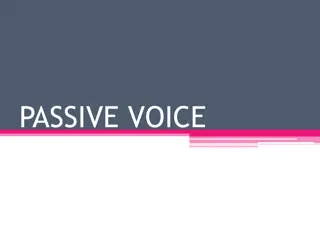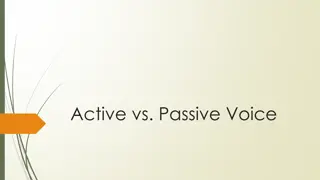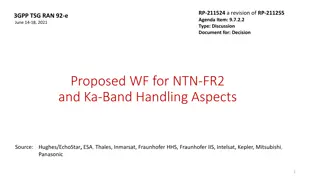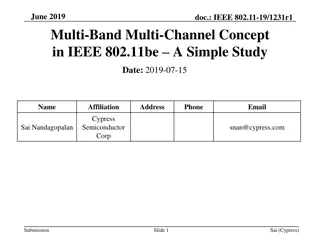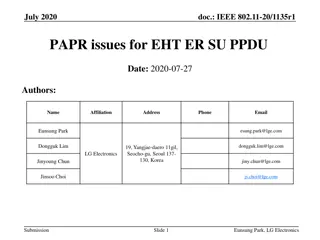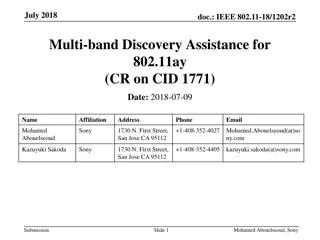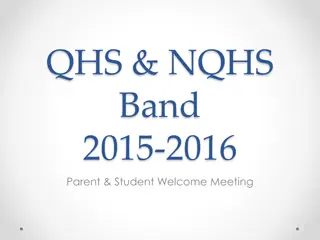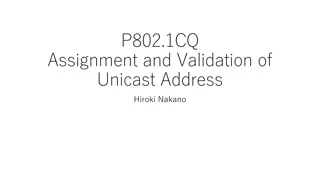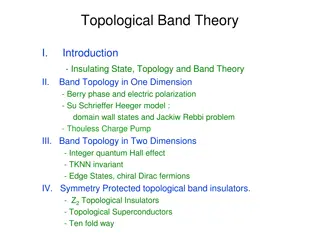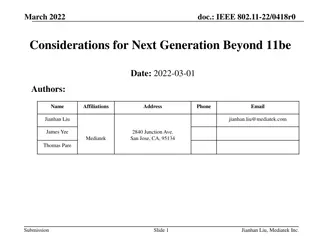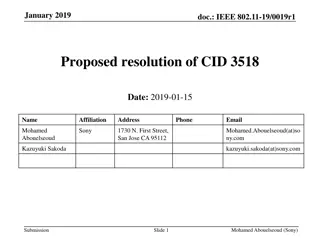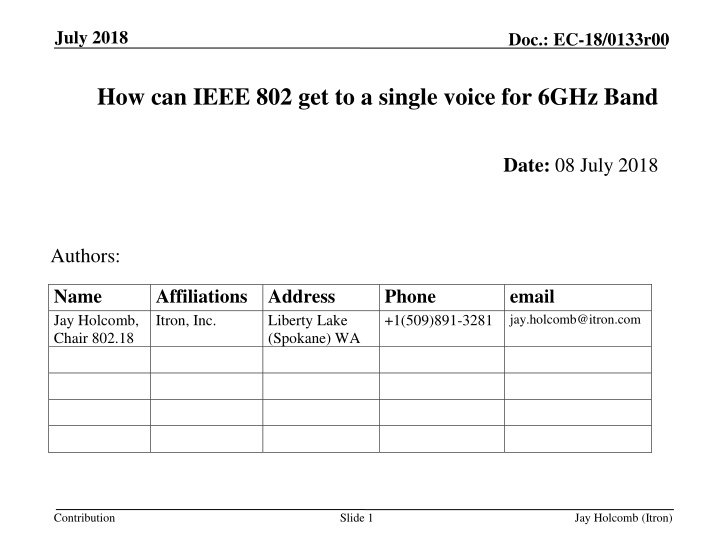
IEEE 802 Response to 6GHz Band Regulation Challenges
Explore how IEEE 802 is working towards a unified voice in response to regulatory challenges surrounding the 6GHz band. Learn about the FCC NPRM, coordination with other organizations, and potential options for industry collaboration. Stay informed on the latest developments and potential outcomes in the ongoing discussions.
Uploaded on | 0 Views
Download Presentation

Please find below an Image/Link to download the presentation.
The content on the website is provided AS IS for your information and personal use only. It may not be sold, licensed, or shared on other websites without obtaining consent from the author. If you encounter any issues during the download, it is possible that the publisher has removed the file from their server.
You are allowed to download the files provided on this website for personal or commercial use, subject to the condition that they are used lawfully. All files are the property of their respective owners.
The content on the website is provided AS IS for your information and personal use only. It may not be sold, licensed, or shared on other websites without obtaining consent from the author.
E N D
Presentation Transcript
July 2018 Doc.: EC-18/0133r00 How can IEEE 802 get to a single voice for 6GHz Band Date: 08 July 2018 Authors: Name Jay Holcomb, Chair 802.18 Affiliations Address Itron, Inc. Phone +1(509)891-3281 email jay.holcomb@itron.com Liberty Lake (Spokane) WA Contribution Slide 1 Jay Holcomb (Itron)
July 2018 Doc.: EC-18/0133r00 IEEE 802 Can we get to a Single Voice on 6GHz? Word is the FCC NPRM (Notice of Proposed Rulemaking) on 6GHz band should be out before the end of the year, and could be as soon as September. Comment period could be shorter, tbd. With that we need to understand in what direction IEEE 802 as a whole should (or should not) respond to the NPRM with. Reminder: IEEE P802.11ax wants this band for spectrum expansion that WiFi needs. Keep in mind, others, e.g. 3GPP also want the band. IEEE 802.15.4, UWB, is already in use in the band, and is the band most used around the world for 802.15.4-UWB. The concern is WiFi interferes with UWB with its very low power. Recently 802.19 voted on the .11ax CoEx document and it failed. This is being worked on through the normal IEEE 802 process, to be updated and part upcoming letter ballot, etc. There are a number of other incumbents in USA and the EU concerned with coexistence. Contribution Slide 2 Jay Holcomb (Itron)
July 2018 Doc.: EC-18/0133r00 How does IEEE 802 responds to regulators on 6GHz Also, IEEE BTS (Broadcast Technical Society) is on FCC record with reply comments on the NOI, does not want change in the 6 GHz band w/o proven sharing. https://mentor.ieee.org/802.18/dcn/17/18-17-0139-00-0000-ieee-bts-reply-comments-on-mid-band-noi.pdf While some sharing opportunities eventually may exist in these bands, the Commission must not allow unlicensed operations in these bands until proven mechanisms are available that can reliably prevent interference with incumbent users. Goals today: Primary (Stretch) Goal: Either define a single voice for IEEE 802 on the 6GHz band for all regulators, starting with the FCC. or propose some next steps or guidance on how to get to, how IEEE 802 should respond to regulators. Secondary Goals: Be sure the affected working groups are in sync. Current status of what has transpired lately. Contribution Slide 3 Jay Holcomb (Itron)
July 2018 Doc.: EC-18/0133r00 6GHz possible options for IEEE 802 response(s) Options, if no consensus: Nothing from IEEE 802 at all. Not ideal from an IEEE 802 view. Stay with 2 filings to the FCC and other regulatory bodies. Process allows for WG filings, so 802.11 and 802.15 both could file. Would still need from EC no one objects approval (5 day if not in a meeting) Not ideal from an IEEE 802 view. One opinion is this would give regulators both sides they can weigh with the other inputs they get. Report from IEEE 802 with both views, e.g. like DSRC. Time to do might be an issue? Preferred outcome: We have consensus on a plan to have all IEEE 802 technologies use the band together. Contribution Slide 4 Jay Holcomb (Itron)
July 2018 Doc.: EC-18/0133r00 6GHz IEEE 802 regulator response(s), next steps? Goal/Guidance: 802.19, with 802.11ax, will work through the 802.11ax coexistence document through the process so it is updated, passes 802.19 and can be in an upcoming 802.11ax letter ballot. 802.18 will stay involved with this, developing possible comments, at least an outline or high level topic areas. Once the 802.11ax coexistence document is approved, 802.18 can work possible comments. However until the NPRM actually comes out, we will not be sure what is in them exactly to know just how to do final comments. Timing? Until the NPRM is published in the Federal Register, no way to speculate very close the date comments will be due. Speculating the shortest time frame is the NPRM is published early September with a 30 day comments period. Making them due mid-October between the September Interim and November plenary. Contribution Slide 5 Jay Holcomb (Itron)
July 2018 Doc.: EC-18/0133r00 The following slides reference material The following slides are some of the recent history on the subject, for reference and consideration. 802.15.4z has gone through some co-existence brainstorming ideas. TG15.4z ELR (ENHANCED LOW RATE UWB RFID PHY) 802.18 identified some CoEx criteria and use-cases that could be considered to help on approach to the band for IEEE 802. Then a copy-paste mostly of a fair number of emails from many folks over a few weeks in April. They are not in any particular order and some are similar. Not all the context is around them, though they stand alone fairly well. And they are mostly opinions by other individuals. Contribution Slide 6 Jay Holcomb (Itron)
July 2018 Doc.: EC-18/0133r00 A few Coexistence Brainstorming Idea (15-18-0254; 19-18/0040) -1 UWB scan receiver that looks for interference, and then go to a different channel Too costly for UWB RTLS tags Coexistence control channel interface for scheduling Too costly for UWB RTLS tags Trigger 802.11ax CSMA to cause 802.11ax and 3GPP LAA to back off Possible if these devices can be made to sense pulses What about 3GPP LAA in the 6 GHz band Does 802.11ax anticipate the arrival of 3GPP LAA (yes) Can 802.11ax and LAA use the same power levels as UWB? ??? (unlikely) Contribution Slide 7 Jay Holcomb (Itron)
July 2018 Doc.: EC-18/0133r00 A few Coexistence Brainstorming Idea (15-18-0254; 19-18/0040) -2 Can 802.11ax and LAA use adaptive power control Sense UWB and restrict power? Raise UWB power level to match 802.11ax and LAA Not desirable because it will shorten battery life, but could be a solution if we jointly petitioned FCC and ECC (EU s Electronic Communications Committee) (so a rule change) Duty cycle for 802.11 and LAA? Could there be a predictable duty cycle on a local basis? (ETSI has a duty cycle) For future products can the FCC (unlicensed) power limit be increased at 6.5 GHz. WGFM (Working Group Frequency Management; CEPT-ECC SE45 and FM57 groups) appears to be restricting 6 GHz broadband to less than 6.425 GHz in the EU (per current EC, European Commission, mandate). If this is limited to 6.3 GHz, then 802.11ax would have (>)340 MHz of new bandwidth, and UWB centered at 6.55 GHz would have a clear channel Is this a possibility for 802.11ax? Contribution Slide 8 Jay Holcomb (Itron)
July 2018 Doc.: EC-18/0133r00 WiFi / UWB Coexistence -1 What criteria should be considered? Power out needed, different for each technology. Bandwidth considerations. Channel sense, e.g. LBT. Incumbent protection. Interference types, blocks .vs. range decrease. Operational ranges themselves. Different modulation types . Tuning range of UWB (global considerations). Is there a way to identify that UWB is there and transmitting? Contribution Slide 9 Jay Holcomb (Itron)
July 2018 Doc.: EC-18/0133r00 WiFi / UWB Coexistence -2 What Use Cases should be considered? Higher speed (wider BWs) for WiFi users, e.g. streaming video, etc. Global availability (S. Korea has a consultation 6 10.2 GHz for UWB) UWB applications - From 15-17/0660, e.g. location is a significant use case. Security of infants and geriatrics in a hospital/home setting Safety of personnel operating in proximity to machinery Guidance/safety of first responders, e.g. firefighters entering smoke filled buildings Automotive passive entry systems based on secure proximity detection Position based secure access to buildings, and, position based payment systems. Security of inmates/staff in a prison setting General indoor navigation, autonomous robot guidance, factory automation, smart home Sports tracking Where devices are used, height, indoor/outdoor, etc. Review IEEE 802.15.2 (withdrawn) coexistence of WiFi / BT / Co-located in a device, and non-co-located. Contribution Slide 10 Jay Holcomb (Itron)
July 2018 Doc.: EC-18/0133r00 6GHz a few of the points brought up by others -1 There are different regulations covering the same bands in some cases already. Yet there is still an effort on the part of the FCC and regulators in other regions to ensure the various licensed exempt rules provide some sort of fairness. E. g. Part 15.247 includes provisions such as spreading and temporal limits that give devices operating at the power limits of FCC Part 15.249 a reasonable chance. There is nothing physical nor regulatory that is preventing 802.11 and WFA (WiFi Alliance organization) developing and advocating technologies in the band that meet the current rules for license exempt operation. The change being sought would be to use power levels more than 60 dB higher than what is currently allowed in the band for unlicensed operation Contribution Slide 11 Jay Holcomb (Itron)
July 2018 Doc.: EC-18/0133r00 6GHz a few of the points brought up by others -2 802 has made a commitment that we consider coexistence of different 802 wireless technologies, above and beyond the natural selection of the license exempt jungle; This too is a key difference between the LAA (and LTE-U) example where there is no such requirement. Given the commitment by 802 to promote coexistence, it seems contradictory to issue a recommendation from 802.18 or any other 802 WG that promotes poor coexistence in the band. The (6GHz WIFi) coalition is asking that those rules (at 6GHz) be changed in a way that will be harmful to UWB devices operating with the existing rules. LTE-U did not require rule changes. 802.11 should be proving how it will coexist and not disrupt the 802.15 UWB deployments before 802.18 should even consider advocating a change to the 6 to 7 GHz band regulations. Contribution Slide 12 Jay Holcomb (Itron)
July 2018 Doc.: EC-18/0133r00 6GHz a few of the points brought up by others -3 We can t ignore UWB. Neither can the FCC. Right now they are being bombarded by the 6 GHz coalition. It cannot hurt to bring this to their attention. They wrote rules to support UWB, and now if they change these rules, with a serious impact on a small, but viable industry they helped to create, they can t just ignore them. (The 6GHz coalition) Google, Microsoft, Intel, HPE, Apple and others are currently battling the AT&Ts and Verizons of this world to enable Wi-Fi in 6 GHz. They have been at it for almost two years, and have spent beaucoup dollars on the effort. If they fail, UWB in 6 GHz will be safe, but if they succeed, they will not let UWB stand in the way. FCC would likely refrain from getting in the middle of this discussion as the spectrum in question is unlicensed and as long as you follow Part 15 rules they are good. The only other regulators to care about this would be European regulators, China, and possibly Japan. Most other countries may not care. Contribution Slide 13 Jay Holcomb (Itron)
July 2018 Doc.: EC-18/0133r00 6GHz a few of the points brought up by others -4 Having said that, FCC is unlikely to spend time on re-visiting rules for co-existence between 802 technologies. Yes, they helped create UWB rules which came prior to Wi-Fi, but from time to time FCC likes to experiment by creating rules to promote innovation for new and upcoming technology to operate. Some make it others don t, e.g. 3.5 GHz . The issue is internal to 802. agree emphatically that the 'got there first' is not an effective argument. Taking that tact will be no benefit to any 802 interest IMO. Because the two standards have equal footing in 802, 802.18 cannot favor one over the other, regardless of who got there first. We should not make recommendations to regulators which we know are not in the best interest of 802. Contribution Slide 14 Jay Holcomb (Itron)
July 2018 Doc.: EC-18/0133r00 6GHz a few of the points brought up by others -5 It is 802 and 802 issue alone. Don t expect sympathy from regulators. The FCC has limited interest in coexistence between unlicensed technologies. A more recent example was the issue of coexistence between Wi-Fi and LTE- U. The FCC was not happy about being forced to be involved and got out of the way as soon as they could. They are not involved at all in Wi-Fi coexistence issues with LAA/eLAA/feLAA/MulteFire/NR-U, leaving up to the industry to sort it out with themselves The Europeans regulators also generally avoid getting involved in such matters . However, in Europe they at least have forums where such matters are discussed. For example Wi-Fi/LAA coexistence has been a matter of long discussion in ETSI BRAN. In the EU, UWB has already been determined to be lower priority than RLAN, so not equal footing. (There is some debate if this is true, maybe an interpretation difference among different individuals) Contribution Slide 15 Jay Holcomb (Itron)
July 2018 Doc.: EC-18/0133r00 6GHz a few of the points brought up by others -6 15.5 General conditions of operation. (a) Persons operating intentional or unintentional radiators shall not be deemed to have any vested or recognizable right to continued use of any given frequency by virtue of prior registration r certification of equipment, or, for power line carrier systems, on the basis of prior notification of use pursuant to 90.35(g) of this chapter. . It is within the scope of 802.18 to make recommendations to other WGs when we identify effort that falls in the scope of those WGs. When 802 WGs issue conflicting positions it harms the effectiveness of the 802 "voice" overall. The RR-TAG is to develop a strong, common, and supportable position which considers the value of 802 as a whole. 802.18 should be the primary for regulatory submissions as a 'best practice'. Contribution Slide 16 Jay Holcomb (Itron)
July 2018 Doc.: EC-18/0133r00 6GHz a few of the points brought up by others -7 1. (best practice) Handle the regulatory submissions in the prime working groups, but be sure to talk with each another. Don't present a wholly inconsistent position since regulatory bodies view all of IEEE 802 as typically speaking with a single voice. 2. (non-interference) Worry primarily about IEEE specified creations causing interference that negatively affects licensed allocated services. If the IEEE creation tramples over licensed services, regulators and incumbent stakeholders will challenge your petition, resulting in a time consuming and expensive regulatory battle that you will likely lose. 3. (coexistence) It's the IEEE's job (and the industry as implementers) to determine the value of complimentary wireless technologies, and figure out how to make them work together. Jim's example of WiFi combo chips using 802.15.2 best practices eliminated the need for exotic RF detection mechanisms. That's the innovate and thinking outside of the box contribution from cooperating IEEE participants which made such commercially viable solutions possible. Contribution Slide 17 Jay Holcomb (Itron)
July 2018 Doc.: EC-18/0133r00 6GHz a few of the points brought up by others -8 1) The previous approach was to have 802.15 and 802.11 make separate submissions to regulators. It will be very frustrating to try to reach consensus in 802.18; (it is not expected) 802.18 to come to a common position, so a recommendation we continue separately going forward . 2) (spent) years lobbying regulators to get UWB approved - visiting regulators in the US, UK/EU, Japan, China, Singapore, Hong Kong, and probably some other countries. Every single one of them was concerned about UWB interference into licensed or allocated users of the band. Exactly zero cared about interference that other systems would cause for UWB. That's the way unlicensed regulations work. Complaining to a regulator that one unlicensed technology may interfere with another unlicensed technology isn't going to get a sympathetic reception, IMO. 3) have had numerous discussions with regulators about interference between unlicensed technologies. They all say that it's not a regulatory problem - if W-Fi and Bluetooth interfere in 2.4GHz or cordless phones and Wi-Fi interfere in 5GHz, they don't care. Their job is not to protect unlicensed services from each other. You don' t have to look any further than the 2.4GHz ISM band to see that the FCC doesn't care if Wi-Fi, Bluetooth, webcams, baby monitors, and cordless phones are stepping all over each other. 4) If the market needs a solution, people will figure it out, just like they did the Wi- Fi/Bluetooth coexistence techniques --- billions of combo chips have now been shipped that use the Wi-Fi/Bluetooth recommended practice developed in 802.15.2. Slide 18 Contribution Jay Holcomb (Itron)
July 2018 Doc.: EC-18/0133r00 Thank You Contribution Slide 19 Jay Holcomb (Itron)
July 2018 Doc.: EC-18/0133r00 Reference: 802.18 Radio Regulatory Advisory Group RR-TAG Schedule this week, is the normal: Tuesday AM2 Cortez Hill AB Thursday AM1 Cortez Hill AB Proposed Bonus listen into the FCC Open Meeting, Thursday 07:30 Extra if needed, Thursday AM2 Cortez Hill AB Core Agenda: EU Activities status Ofcom WRC-19 consultation (primary discussion this week) NPRM on 3.7 to 4.2 GHz Band Plan to listen into FCC Open Meeting. IEEE 802 6 GHz single voice status Google waiver input TR-51 SUN meeting invite Time for teleconferences Contribution Slide 20 Jay Holcomb (Itron)
July 2018 Doc.: EC-18/0133r00 All of 15.5 15.5 General conditions of operation. (a) Persons operating intentional or unintentional radiators shall not be deemed to have any vested or recognizable right to continued use of any given frequency by virtue of prior registration or certification of equipment, or, for power line carrier systems, on the basis of prior notification of use pursuant to chapter. (b) Operation of an intentional, unintentional, or incidental radiator is subject to the conditions that no harmful interference is caused and that interference must be accepted that may be caused by the operation of an authorized radio station, by another intentional or unintentional radiator, by industrial, scientific and medical (ISM) equipment, or by an incidental radiator. (c) The operator of a radio frequency device shall be required to cease operating the device upon notification by a Commission representative that the device is causing harmful interference. Operation shall not resume until the condition causing the harmful interference has been corrected. (d) Intentional radiators that produce Class B emissions (damped wave) are prohibited. [54 FR 17714, Apr. 25, 1989, as amended at 75 FR 63031, Oct. 13, 2010] 90.35(g) of this Contribution Slide 21 Jay Holcomb (Itron)

